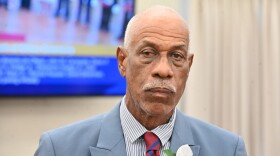ST. CROIX — After the removal of several mahogany trees at Maná Deli Restaurant led to part of one falling on a nearby rental unit, the neighboring property owner is seeking compensation from the contractor to cover damages.
Carla Andrews, owner of the property in Estate Peter’s Rest next door to Maná, said she was thankful nobody got hurt after part of the tree fell on a dwelling she rents out.
“I can always deal with material things, but thank God somebody’s life wasn’t taken,” she said.
The incident happened about two weeks ago when PC Landscaping and Water Delivery was removing multiple mahogany trees from the restaurant’s property. Photos of the removal posted and reposted on social media triggered comments noting the importance of trees to the ecosystem and the cultural significance of mahogany trees while questioning why they would be cut down.
Andrews said the roof of her rental unit got damaged during the process. She said nobody was home at the time, but rainwater now leaks inside.

Andrews said she was not contacted prior to the removal of the trees, including one that was located on the property line.
“We work very hard to build up what we’re doing, and we have so much more to do out there,” Andrews said, noting another tenant on her property sells clothes. “For somebody to just come in there and do something like that, and not say anything on top of it, I am very, very appalled.”
Andrews said she would reach out to the parties involved to discuss a resolution since her building got damaged.
“I’m going to try my best to contact each and every one of them, have a talk with them because there must be compensation, of course, and then we’ll take it from there to know for sure,” she said.
Theresa Clifford, co-owner of PC Landscaping, said the person who owns the property where Maná is located hired her company to remove the trees.
“We only did the job because it was requested,” she said.

Clifford said she would like to speak with Andrews about the available options to address the damages to the rental unit.
“If I get the owner, then we could discuss it,” she said. “If she gives us a call, we could take it from there.”
Andrews subsequently contacted Clifford to discuss the matter. After the conversation, Andrews said she felt she would be compensated for the damage to her rental unit.
“She was very sympathetic,” Andrews said about Clifford, noting the next step would be to obtain an estimate to repair the damages.
Before hiring PC Landscaping to remove the trees, the property owner failed to obtain a permit through the Virgin Islands Department of Agriculture as required by law, according to Preston Brooks, VIDA Urban and Community Forestry program coordinator. He wrote in an email response to WTJX that he was told upon investigating the matter that a permit was obtained through the Virgin Islands Department of Planning and Natural Resources.
Jamal Nielsen, DPNR spokesperson, clarified the regulatory agency does not issue tree-removal permits. He said VIDA is responsible for issuing the permits.

The Community and Heritage Tree Law of the Virgin Islands, Act No. 8149, which was enacted January 6, 2019, requires applications to remove a public tree be submitted to VIDA for approval.
READ MORE: “Law enacted in 2019 fails to prevent public trees from getting cut down along roads”
While the mahogany trees on the property at Maná are private trees, the law also protects “heritage trees” from being removed unless there is an overriding need for public improvements, or a severe hardship exists for reasonable use of a site.
The tree law, which amended the Virgin Islands Code, Title 12, indicates in Section 134 that “heritage tree” means “any tree, public or private, which is determined pursuant to this chapter to be of intrinsic value to the general public because of its species, size, age, location, ecological importance, historical and cultural significance, aesthetic value, economic benefit, special character, or community benefit.”
The tree law, in Section 136, establishes the Virgin Islands Tree Board to protect, manage, remove, and establish trees on public property within the Virgin Islands. The VI Tree Board shall also identify, protect, and care for heritage trees that are of cultural, biological, and historical significance in the Virgin Islands.
Brooks wrote in an email that property owners must obtain a permit to remove heritage trees on private property. He clarified that the Tree Board should identify heritage trees but noted the Urban and Community Forestry Tree Council has already begun compiling a list, which includes the mahogany tree. He wrote that he is in the process of establishing the Tree Board.
Any person or entity that violates any provision of the tree law by causing, contributing to, or permitting the injury of, removal, or destruction of a public tree, shrub, or a heritage tree is subject to a civil penalty between $100 to $500 for each violation.















